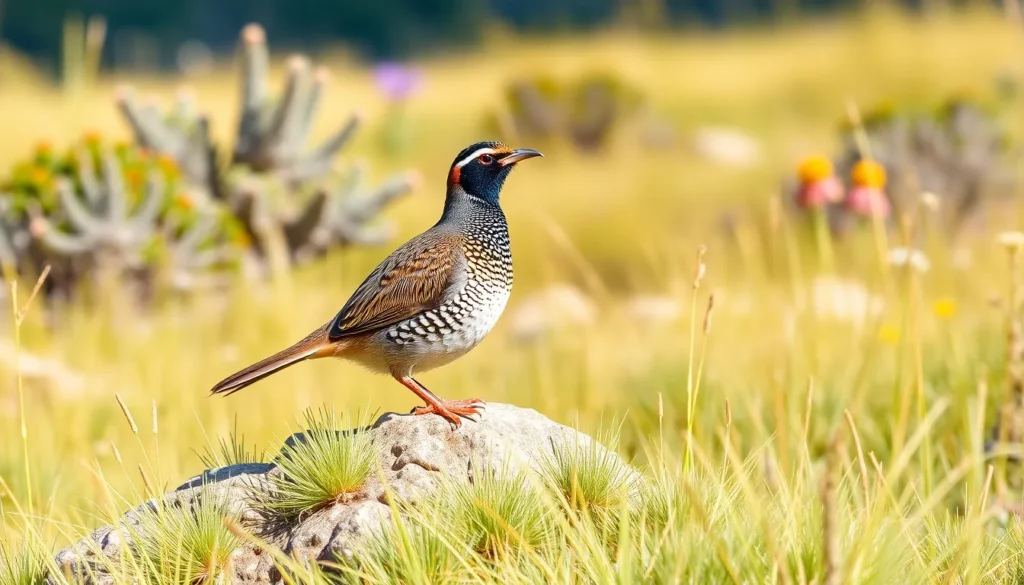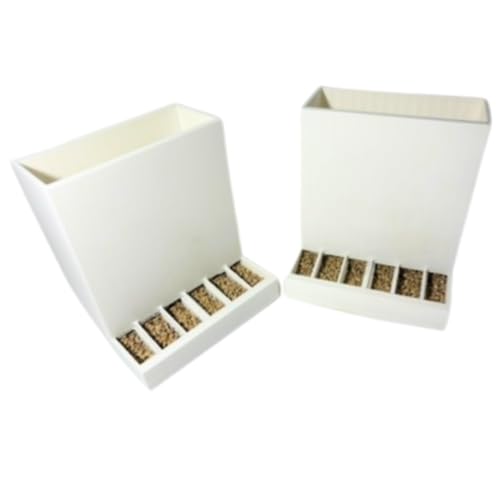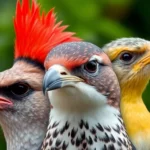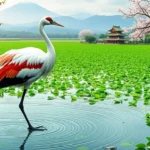We’ve all heard the phrase “small but mighty” but few creatures embody this concept quite like the remarkable quail bird. These pint-sized game birds pack an incredible amount of personality and survival skills into their compact frames. From their distinctive plumage patterns to their lightning-fast ground sprints, quails continue to captivate bird enthusiasts and hunters alike across North America.
What makes these feathered dynamos so special? We’re talking about birds that can reach speeds of up to 15 mph on foot and possess an uncanny ability to vanish into the underbrush at a moment’s notice. Their characteristic “bob-white” calls echo through grasslands and woodlands, serving as nature’s own communication network.
Whether you’re a seasoned birder looking to expand your knowledge or simply curious about these fascinating creatures, we’ll dive deep into the industry of quail birds. You’ll discover their unique behaviors, habitat preferences, and why they’ve earned such respect in the avian community.
What Is a Quail Bird
Quail birds belong to the family Phasianidae and represent small ground-dwelling game birds found across multiple continents. These compact birds typically measure 4 to 7 inches in length and weigh between 2 to 5 ounces depending on their species. Over 130 species of quail exist worldwide with the most common varieties including Bobwhite quail, California quail, and Gambel’s quail in North America.
Their distinctive physical characteristics include rounded bodies, short tails, and strong legs designed for ground movement. Quail possess mottled brown and gray plumage that provides excellent camouflage against predators in their natural habitats. Males often display more vibrant coloring with distinctive crests or facial markings that distinguish them from females during mating seasons.
These birds demonstrate remarkable social behavior by living in groups called coveys that typically consist of 8 to 25 individuals. Coveys provide protection through collective vigilance and coordinated escape tactics when threats arise. During breeding season quail pairs separate from the main group to establish territories and raise their young.
Quail habitat preferences include grasslands, agricultural fields, woodland edges, and brushy areas that offer both food sources and protective cover. They consume a varied diet consisting of seeds, insects, berries, and green vegetation depending on seasonal availability. Their foraging behavior involves scratching and pecking at the ground surface to uncover hidden food items.
Communication among quail occurs through various vocalizations with each species producing unique call patterns. The iconic “bob-white” call serves as a contact call between scattered flock members while other sounds signal alarm, aggression, or mating intentions. These vocal communications help maintain group cohesion and coordinate daily activities across their territory.
Physical Characteristics of Quail Birds
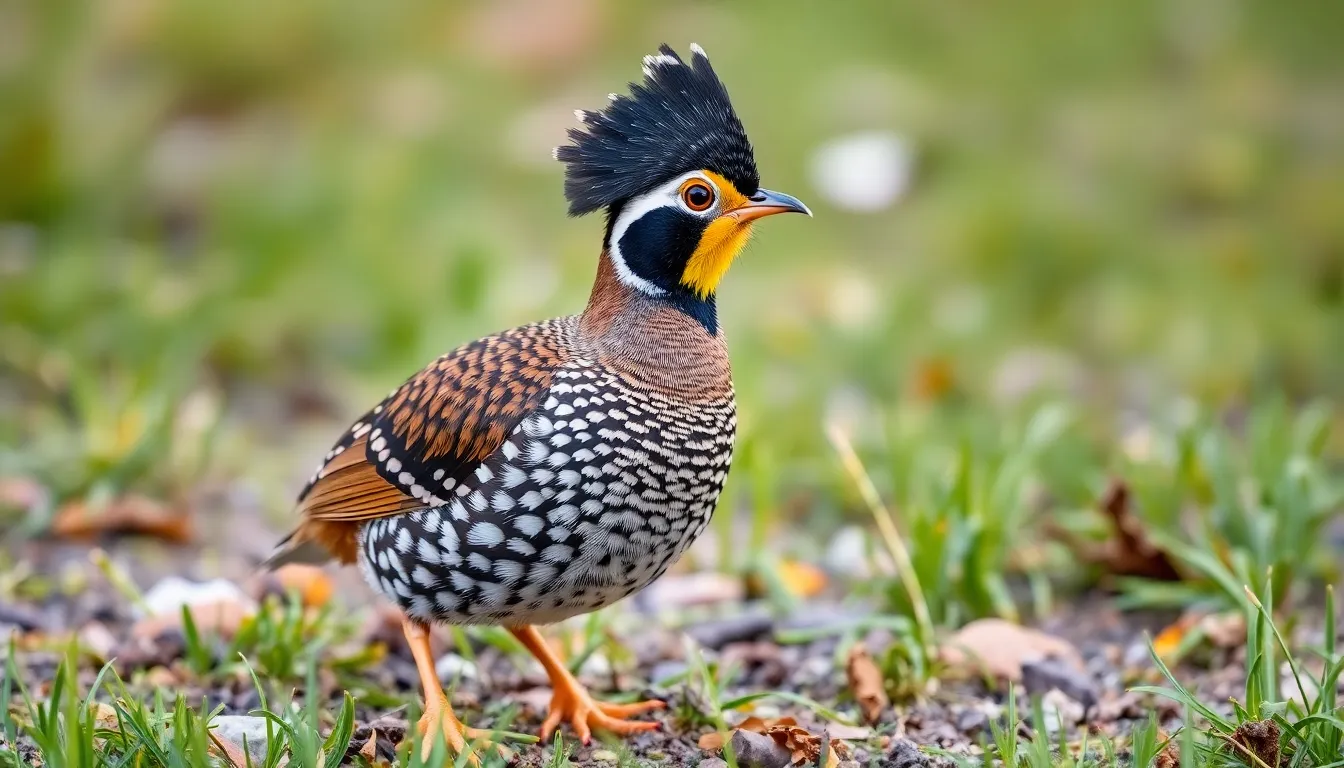
Quail birds showcase remarkable physical adaptations that enable their ground-dwelling lifestyle across diverse environments. These compact game birds display consistent anatomical features while maintaining species-exact variations in coloring and markings.
Size and Weight
Adult quail birds measure between 4 to 7 inches in length from beak to tail. Most species weigh 2 to 5 ounces with females typically carrying slightly more weight than males during egg-laying periods. Bobwhite quail average 6 inches in length and weigh approximately 6 ounces. California quail reach 9 to 11 inches including their distinctive head plumes and weigh 5 to 7 ounces. Gambel’s quail measure 10 inches in length and maintain weights between 5.3 to 6.7 ounces.
| Species | Length (inches) | Weight (ounces) |
|---|---|---|
| Bobwhite | 6 | 6 |
| California | 9-11 | 5-7 |
| Gambel’s | 10 | 5.3-6.7 |
Distinctive Features and Coloring
Rounded bodies and short tails characterize all quail species with strong legs built for rapid ground movement and scratching behavior. Males display more vibrant plumage during breeding seasons with distinct head markings like the California quail’s curved black plume and white facial stripes. Brown and gray base colors provide natural camouflage against grassland and woodland floor environments. Female quail exhibit muted browns and tans with subtle barring patterns that offer superior concealment while nesting. Black throat patches appear on male Bobwhite quail while females show buff-colored throats with fine dark speckling. Head crests vary significantly between species with some displaying forward-curving plumes and others showing scaled crown feathers that lay flat against the head.
Different Species of Quail Birds
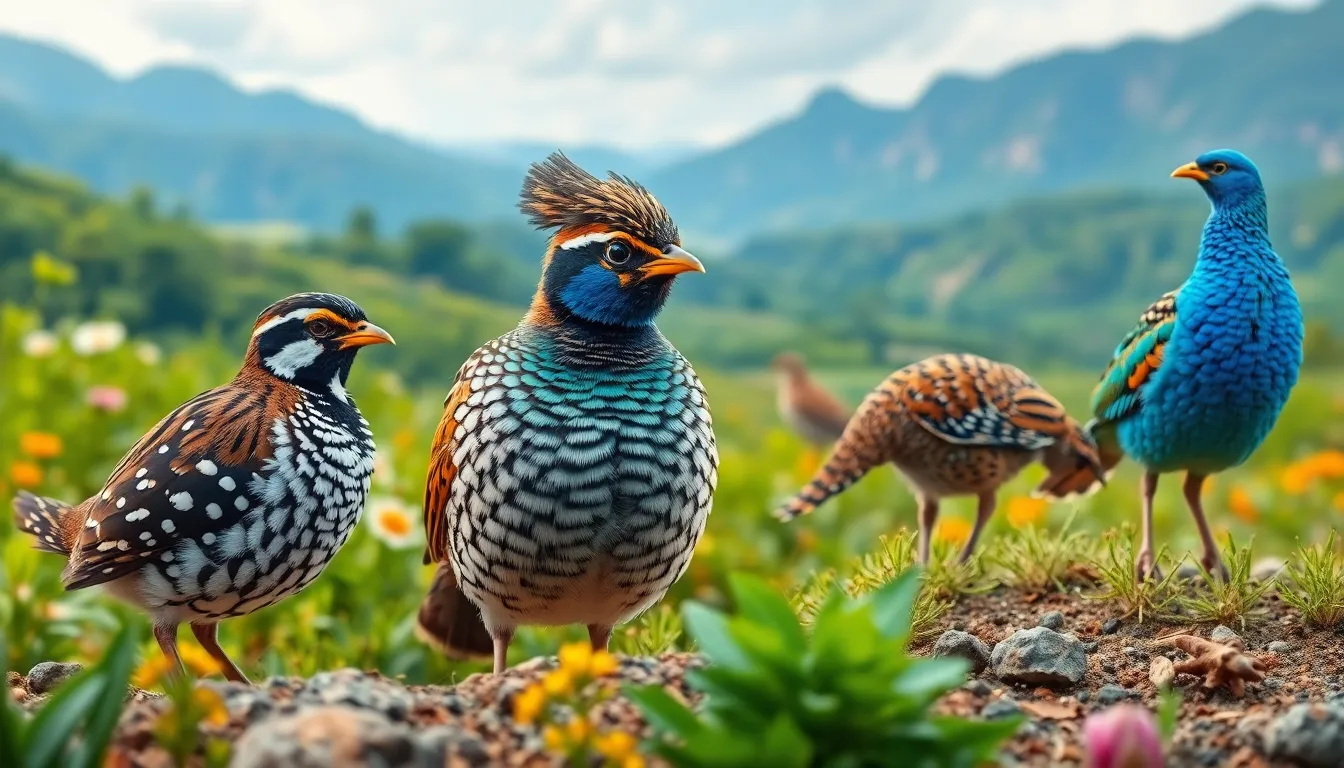
The diversity of quail species spans across continents, with each variety adapting uniquely to its environment. Over 130 distinct quail species exist worldwide, ranging from the familiar North American varieties to exotic international breeds.
Common Quail Species in North America
Bobwhite Quail represents the most recognized species across eastern and central United States. Males display distinctive black and white facial markings during breeding season, while females show more subdued brown coloration for camouflage.
California Quail dominates the western coastal regions with its iconic forward-curving head plume. These birds measure 9 to 11 inches in length and feature scaled underparts with rich chestnut crown markings.
Gambel’s Quail thrives in southwestern desert environments, distinguished by its rust-colored cap and black facial patch. Desert adaptations allow this species to survive in areas with minimal water sources.
Mountain Quail inhabits higher elevation forests from California to Washington state. Two straight head plumes and bold white barring along the sides make this species easily identifiable among North American varieties.
Scaled Quail populates arid regions of the southwestern United States and Mexico. Gray coloration with distinctive scale-like markings gives this species its common name, while white-tipped crests add visual appeal.
International Quail Varieties
Japanese Quail serves as the most commercially important species worldwide for egg and meat production. Domesticated varieties weigh between 3 to 4 ounces and lay approximately 300 eggs annually.
European Quail migrates seasonally across Africa, Europe, and western Asia. This species measures 6.5 to 7 inches in length and produces the classic three-note call familiar in European countryside.
Chinese Painted Quail displays the most vibrant coloration among international species. Males feature bright blue breasts with distinctive facial patterns, while females maintain earth-toned camouflage coloring.
Harlequin Quail inhabits African grasslands and savannas with striking black and white facial markings. These birds form large coveys during non-breeding seasons, often exceeding 100 individuals.
Brown Quail dominates Australian landscapes from coastal areas to inland regions. Adaptability to diverse habitats makes this species one of Australia’s most successful ground-dwelling birds.
| Species | Length (inches) | Weight (ounces) | Primary Region |
|---|---|---|---|
| Bobwhite Quail | 8-10 | 5-6 | Eastern North America |
| California Quail | 9-11 | 5-7 | Western North America |
| Japanese Quail | 6-7 | 3-4 | Asia (domesticated worldwide) |
| European Quail | 6.5-7 | 2-4 | Europe, Africa, Asia |
| Chinese Painted Quail | 4-5 | 1.5-2 | Southeast Asia |
Natural Habitat and Distribution
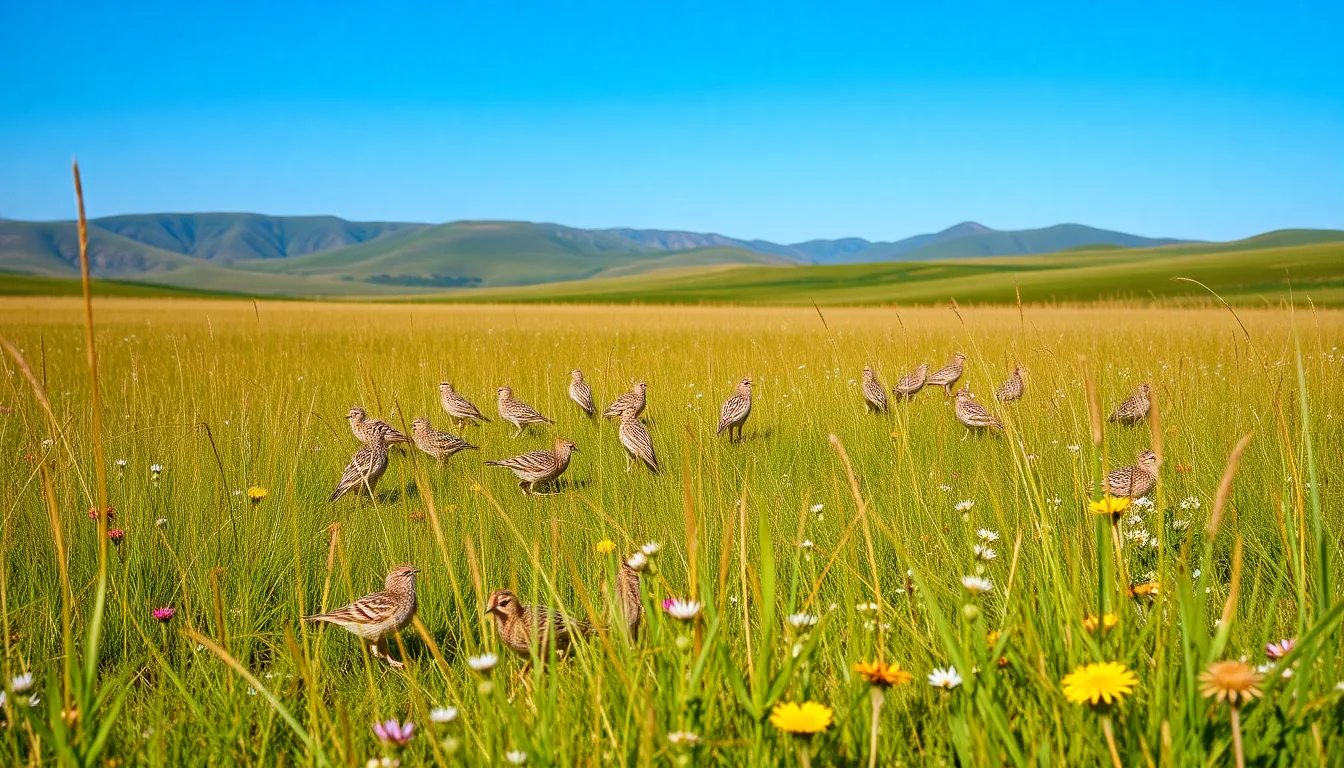
Quail birds inhabit diverse environments across six continents, demonstrating remarkable adaptability to various climatic conditions and terrain types. Understanding their habitat preferences and geographic distribution reveals the extensive reach these small game birds maintain worldwide.
Preferred Environments
Grasslands serve as primary habitat for most quail species, offering abundant seed sources and protective cover from predators. Open woodlands provide the perfect combination of shelter and foraging opportunities that quail birds require for daily survival. Agricultural fields attract these birds due to readily available grains, corn, and other crop remnants scattered throughout farming areas.
Scrubland environments support quail populations through dense vegetation that offers nesting sites and escape routes from aerial predators. Desert regions accommodate specialized quail species like Gambel’s quail, which adapted to arid conditions and sparse water sources. Meadow edges create ideal transition zones where quail access both open foraging areas and nearby shelter.
Elevations ranging from sea level to 10,000 feet demonstrate quail birds’ versatility in altitude preferences. Temperature ranges between 32°F to 100°F accommodate different species across seasonal variations. Rainfall requirements vary significantly, with desert quail surviving on 3 inches annually while woodland species prefer 20 to 40 inches per year.
Geographic Range
| Region | Primary Species | Population Density | Habitat Coverage |
|---|---|---|---|
| North America | Bobwhite, California | 15-30 birds per square mile | 2.3 million square miles |
| Europe | European Quail | 8-20 birds per square mile | 1.8 million square miles |
| Asia | Japanese, Chinese Painted | 25-45 birds per square mile | 4.1 million square miles |
| Africa | Harlequin, Blue Quail | 12-35 birds per square mile | 2.7 million square miles |
| Australia | Brown, Stubble Quail | 10-28 birds per square mile | 1.9 million square miles |
| South America | Elegant, Spot-winged | 6-22 birds per square mile | 1.4 million square miles |
North American quail populations span from southern Canada through Central America, with Bobwhite quail concentrated in southeastern United States farmlands. California quail dominates Pacific coast regions from British Columbia to Baja California, thriving in chaparral and oak woodland ecosystems. Mountain quail inhabits high elevation forests throughout the Sierra Nevada and Cascade mountain ranges.
European quail migrate seasonally between breeding grounds in northern Europe and wintering areas across Mediterranean regions and sub-Saharan Africa. Asian quail species occupy territories from Siberian tundra to tropical Southeast Asian rainforests, showcasing the family’s environmental adaptability. Japanese quail populations extend from eastern Russia through China, Korea, and Japan in both wild and domesticated forms.
African quail species distribute across savanna grasslands, with Harlequin quail particularly abundant in East African plains. Australian quail inhabit continental grasslands and agricultural zones, with Brown quail preferring coastal wetland margins. South American species concentrate in Andean foothills and pampas grasslands, adapting to high altitude conditions and seasonal flooding patterns.
Quail Bird Behavior and Lifestyle
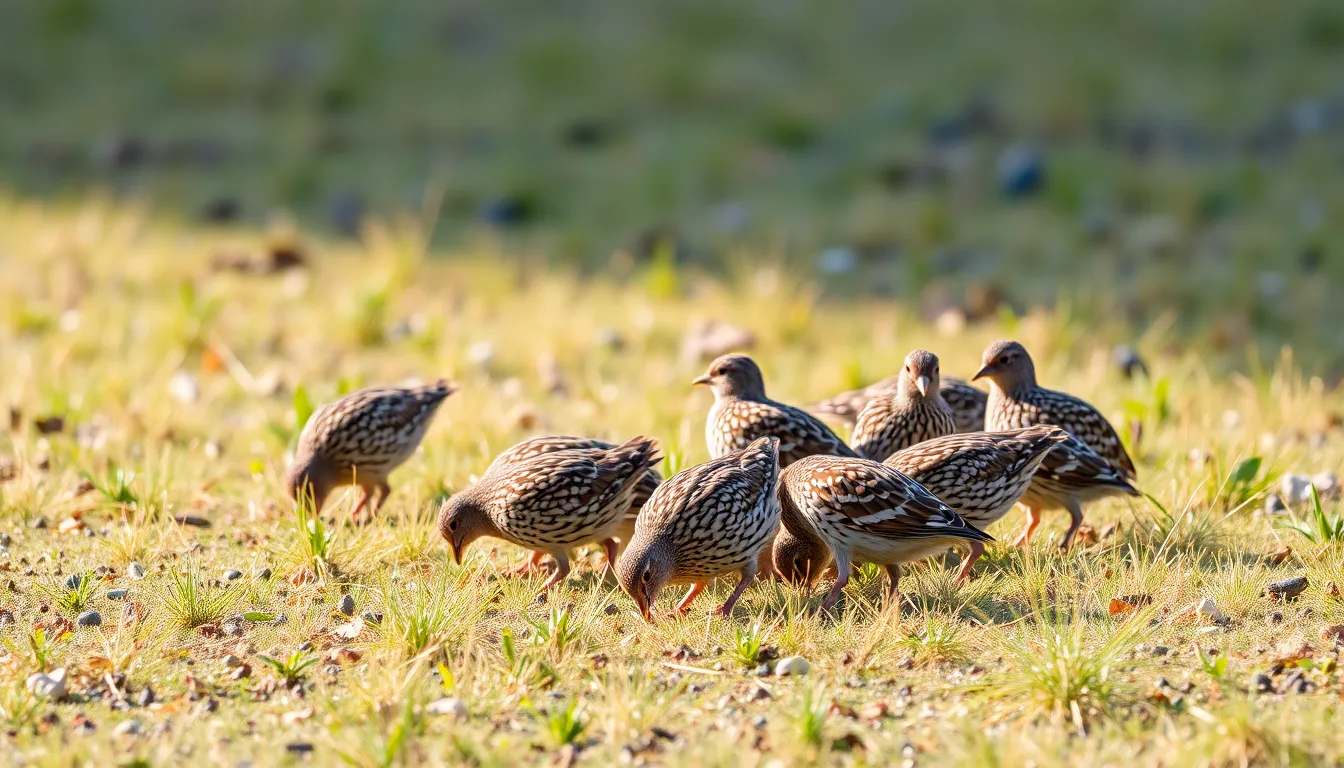
Quail birds demonstrate complex behavioral patterns that reflect their adaptation to ground-dwelling life. These fascinating birds exhibit sophisticated social structures and feeding behaviors that enable their survival across diverse environments.
Social Structure and Flocking Patterns
Coveys form the foundation of quail social organization, containing 8 to 25 individuals that move together throughout most of the year. These groups provide essential protection against predators through collective vigilance and alarm calls. During winter months, coveys become more tightly knit as birds huddle together for warmth and share information about food sources.
Family units within coveys consist of breeding pairs and their offspring from the current season. Males establish dominance hierarchies through ritualized displays rather than aggressive confrontations. Females contribute to group cohesion by maintaining contact calls that keep the covey together during foraging activities.
Territory establishment occurs during breeding season when pairs separate from the main covey. Mated pairs defend areas ranging from 2 to 6 acres depending on habitat quality and food availability. Communication between covey members involves over 20 distinct vocalizations including assembly calls, warning signals, and location markers.
Roosting behavior showcases the cooperative nature of quail social structure. Birds arrange themselves in tight circles with heads facing outward to detect approaching threats. This formation provides maximum protection while allowing rapid escape in multiple directions when danger approaches.
Daily Activities and Feeding Habits
Morning foraging begins at dawn when quail emerge from roosting sites to search for food in open areas. These birds spend 60 to 70 percent of daylight hours actively feeding on seeds, insects, and plant materials. Ground scratching techniques involve using both feet to uncover buried food sources beneath leaf litter and soil.
Dust bathing represents a crucial daily activity that occurs during midday heat periods. Quail create shallow depressions in dry soil and use vigorous wing movements to coat their feathers with dust particles. This behavior removes parasites and excess oils while maintaining proper feather condition for insulation.
Water consumption patterns vary by species and habitat conditions. Desert dwelling quail like Gambel’s obtain moisture primarily from succulent plants and insects. Woodland species visit water sources twice daily during summer months but can survive extended periods without direct water access.
Rest periods occur during extreme temperatures when birds seek shelter under vegetation or rock formations. Afternoon activities include preening sessions where quail use specialized oils to waterproof their feathers. Evening gatherings involve covey reassembly through contact calls before selecting secure roosting locations.
Seasonal feeding behaviors shift dramatically between spring breeding periods and winter survival modes. Breeding females increase protein intake by consuming more insects and larvae. Winter diets focus heavily on high energy seeds from grasses and agricultural crops to maintain body temperature during cold periods.
Diet and Feeding Requirements
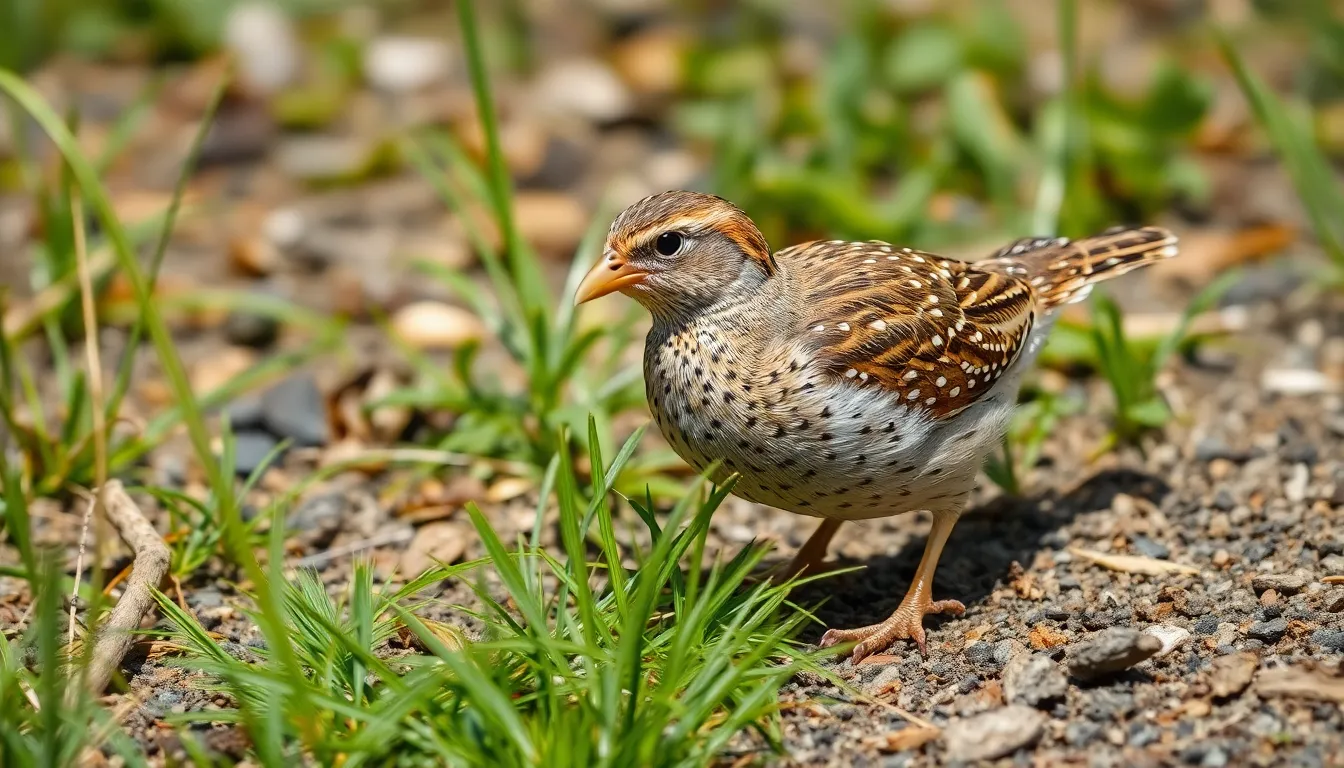
Quail birds maintain an omnivorous diet that adapts to seasonal availability and nutritional demands throughout their lifecycle. Seeds form the primary component of their diet, comprising 60-70% of daily food intake during non-breeding seasons. Grass seeds, grain crops, and wildflower seeds provide essential carbohydrates and fats for energy storage.
Insects constitute a crucial protein source, particularly during breeding season when protein requirements increase to 24-28% of total diet. Beetles, ants, caterpillars, and grasshoppers supply amino acids necessary for egg production and chick development. Adult quails consume approximately 15-20 grams of food daily, with breeding females requiring up to 25 grams during peak laying periods.
Essential Food Sources
Plant materials dominate quail feeding patterns across all habitats and seasons. Agricultural crops like wheat, corn, and soybeans attract quail populations to farming areas. Berries from elderberry, grape, and sumac bushes provide vitamins and antioxidants during autumn months. Green vegetation including clover, alfalfa, and young grass shoots delivers necessary minerals and water content.
Protein sources vary significantly based on habitat availability and seasonal cycles. Ground-dwelling insects like ground beetles and larvae remain accessible year-round in most climates. Flying insects such as flies and small moths supplement protein intake during warmer months. Spiders and small snails contribute additional protein when insect populations decline.
Seasonal Feeding Patterns
Spring feeding behaviors focus heavily on protein acquisition to support reproductive activities. Females increase insect consumption by 40-50% during egg-laying periods to meet calcium and protein demands. Males consume high-energy seeds to maintain territorial displays and courtship behaviors. Fresh green shoots provide essential vitamins after winter’s limited vegetation options.
Summer diets diversify as food sources reach peak abundance across quail habitats. Insects become readily available, allowing adults to meet protein requirements while feeding insects to growing chicks. Ripening seeds from native grasses provide carbohydrates for energy-intensive activities. Water-rich berries help maintain hydration during hot weather periods.
Feeding Behavior and Techniques
Quail birds employ ground foraging techniques that maximize food discovery while maintaining predator awareness. Scratching motions with both feet simultaneously uncover buried seeds and expose hidden insects. Head movements create small disturbances in leaf litter that reveal invertebrates hiding beneath surface debris. Covey members maintain visual contact while spreading across feeding areas to optimize food collection.
Feeding occurs primarily during dawn and dusk hours when predator activity remains relatively low. Morning foraging sessions last 2-3 hours and focus on replenishing energy stores depleted overnight. Evening feeding periods extend 1-2 hours before roosting and emphasize filling crops for overnight digestion. Midday feeding happens only during overcast conditions or when food sources require immediate attention.
Nutritional Requirements by Life Stage
Chick nutrition demands differ dramatically from adult requirements during the first 8 weeks of development. Newly hatched chicks consume 85-90% insects and invertebrates to fuel rapid growth rates. Protein requirements reach 28-30% of total diet during the first month of life. Seeds gradually replace insects as chicks develop adult digestive capabilities around 6-8 weeks of age.
Adult maintenance diets contain 16-18% protein during non-breeding periods and focus on energy conservation. Breeding adults require 20-24% protein to support reproductive functions and territory maintenance. Winter diets emphasize high-fat seeds and nuts to maintain body temperature in cold climates. Calcium intake increases significantly for laying females through consumption of snail shells and limestone grit.
Breeding and Reproduction
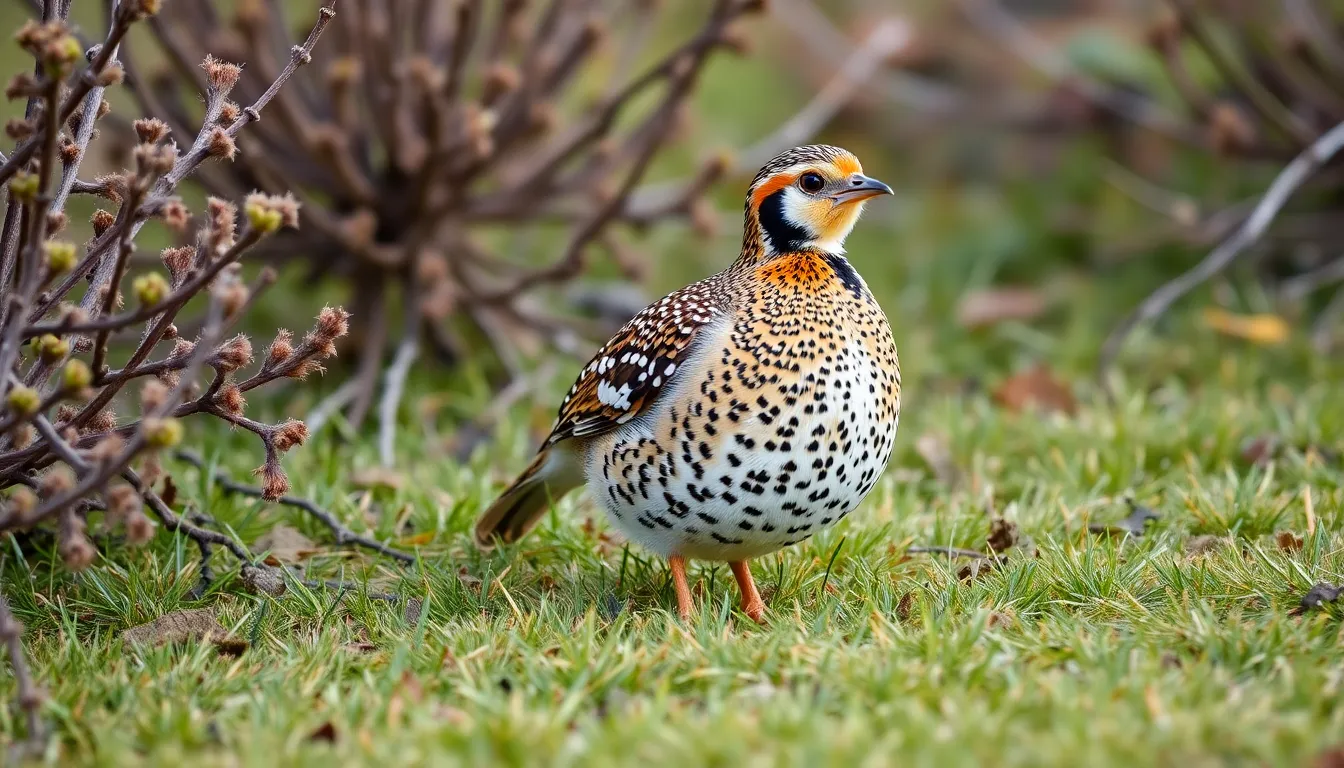
Quail birds display fascinating reproductive behaviors that ensure species survival across diverse habitats. These ground dwelling birds engage in complex courtship rituals and demonstrate remarkable adaptability in their nesting strategies.
Mating Season and Courtship
Breeding seasons for quail birds typically occur between April and September, with peak activity during May through July when environmental conditions optimize reproductive success. Males establish territories ranging from 2 to 6 acres and defend these areas aggressively against competing males through displays and physical confrontations.
Courtship displays involve elaborate performances where males showcase their vibrant plumage and distinctive head markings to attract females. Bobwhite males emit their characteristic “bob-white” calls up to 200 times per hour during peak mating periods. California quail males perform intricate dances, spreading their wings and puffing their chest feathers while circling potential mates.
Territorial males engage in tidbitting behavior, where they pick up food items and present them to females while making soft clucking sounds. Females evaluate multiple suitors before selecting mates, often choosing males with the most vibrant coloration and strongest territorial displays. Pair bonds typically last throughout the breeding season, with some species maintaining monogamous relationships for multiple years.
Nesting and Egg Laying
Female quail birds construct ground nests in shallow depressions lined with grass, leaves, and feathers, creating camouflaged sanctuaries for their eggs. Nest construction takes 3 to 5 days, with females carefully selecting locations that provide overhead cover from shrubs or vegetation while maintaining easy escape routes.
Egg laying begins within 48 hours of nest completion, with females depositing one egg daily during early morning hours. Clutch sizes vary significantly among species, with the following patterns:
| Species | Clutch Size | Egg Color | Incubation Period |
|---|---|---|---|
| Bobwhite Quail | 12-16 eggs | White to cream | 23-24 days |
| California Quail | 10-17 eggs | Buff with brown spots | 21-23 days |
| Gambel’s Quail | 10-12 eggs | Buff colored | 21-24 days |
| Japanese Quail | 7-12 eggs | Brown speckled | 17-18 days |
Incubation duties fall primarily on females, who leave nests only for brief feeding periods lasting 15 to 30 minutes. Males remain nearby to provide protection and alert females to potential threats through warning calls. Females develop brood patches, areas of bare skin with increased blood flow that efficiently transfer body heat to eggs.
Hatching occurs synchronously within 24 hours, as chicks communicate through soft peeping sounds while still inside their shells. Newly hatched quail chicks weigh approximately 6 to 8 grams and possess down feathers that dry within 2 hours of hatching. These precocial young leave the nest within 24 hours and begin foraging independently under parental supervision.
Quail Birds as Game Animals
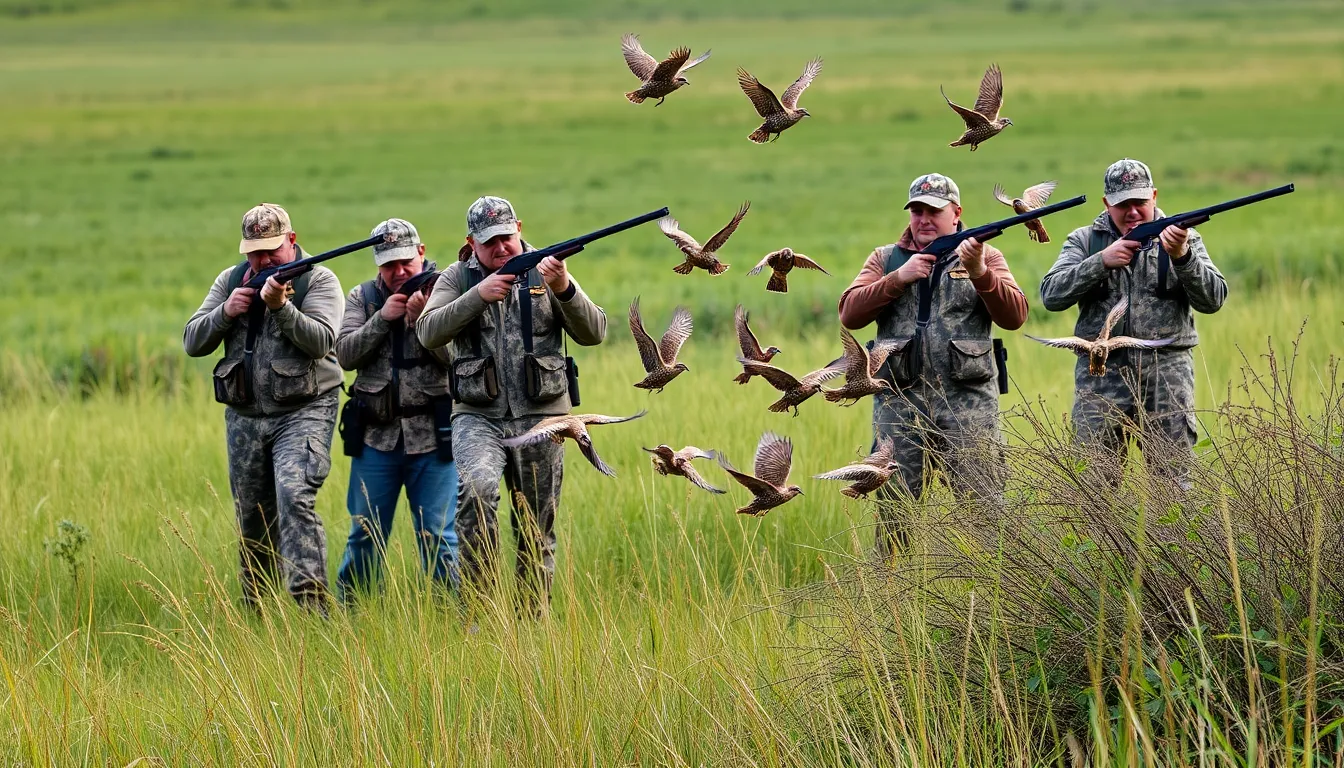
Quail birds represent one of North America’s most pursued small game species, with hunters harvesting approximately 15 million birds annually across the United States. These ground dwelling birds provide challenging hunting opportunities due to their explosive flight patterns and keen survival instincts developed through centuries of predator avoidance.
Traditional Hunting Methods
Traditional quail hunting revolves around the covey flush, where hunters approach groups of 8 to 25 birds that explode into flight simultaneously. Pointing breeds like English Setters and German Shorthaired Pointers locate coveys through scent detection, freezing in position to alert hunters of nearby birds. Walking hunters follow established patterns through quail habitat, moving methodically through grasslands and field edges where coveys congregate.
Flush hunting without dogs requires different techniques, with hunters moving slowly through likely cover areas and listening for the distinctive assembly calls quails use to regroup after disturbances. Success rates increase dramatically when hunters understand quail behavior patterns, particularly their tendency to scatter in predictable directions after initial covey breaks.
Hunting Seasons and Regulations
Hunting seasons for quail vary significantly across states, typically running from October through February in most regions. Daily bag limits range from 8 to 15 birds per hunter, with season lengths varying from 60 to 120 days depending on local population assessments. Georgia maintains one of the longest seasons at 142 days, while states like Kansas and Oklahoma offer generous daily limits of 15 birds.
License requirements include standard small game licenses, with some states requiring additional habitat stamps or conservation fees. Hunter education certification remains mandatory in all states offering quail hunting opportunities, emphasizing safety protocols exact to upland game bird hunting.
Economic Impact of Quail Hunting
Quail hunting generates substantial economic activity across rural communities, contributing approximately $450 million annually to local economies through equipment purchases, guide services, and lodging expenses. Georgia’s quail hunting industry alone supports over 3,500 jobs and generates $78 million in direct economic impact each year.
Hunting preserves and shooting plantations cater to quail enthusiasts, with operations spanning from Texas to North Carolina charging between $350 to $800 per day for guided hunts. These commercial ventures maintain quail populations through habitat management and selective breeding programs, ensuring sustainable hunting opportunities.
Conservation Through Hunting
Hunting license revenues fund critical quail habitat restoration projects, with the Federal Aid in Wildlife Restoration Act directing excise taxes from hunting equipment toward conservation efforts. Quail Forever and similar organizations have restored over 2.3 million acres of quail habitat since 1981, directly benefiting wild quail populations.
Hunter participation in citizen science programs provides valuable population data, with annual breeding bird surveys incorporating hunter observations to track quail distribution and abundance trends. This collaborative approach between hunters and wildlife biologists strengthens conservation strategies and ensures sustainable harvest levels.
| Species | Peak Season | Daily Bag Limit | Primary States |
|---|---|---|---|
| Bobwhite Quail | November-January | 8-15 birds | Georgia, Texas, Kansas |
| California Quail | October-January | 10 birds | California, Nevada, Oregon |
| Gambel’s Quail | October-February | 15 birds | Arizona, New Mexico |
| Scaled Quail | November-February | 15 birds | Texas, New Mexico, Colorado |
Raising Quail Birds in Captivity
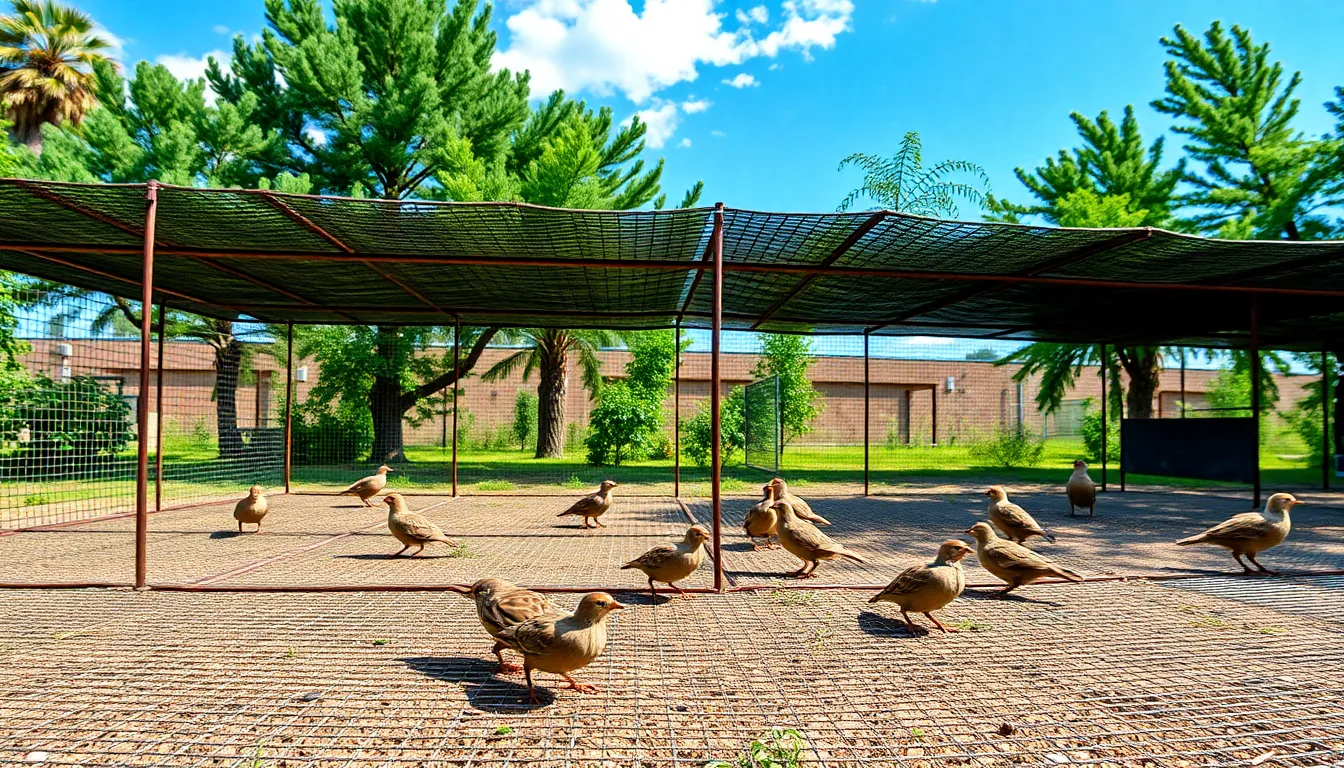
Raising quail birds in captivity provides enthusiasts with an captivating opportunity to observe these remarkable ground dwelling birds up close. Captive quail management requires exact housing conditions and adherence to local regulations for successful breeding and care.
Housing and Care Requirements
Housing quail birds begins with constructing appropriate enclosures that accommodate their natural ground dwelling behaviors. Flight pens measuring 8 feet by 4 feet by 6 feet high provide adequate space for 6 to 8 adult quail, allowing room for natural movement patterns without overcrowding.
Essential Housing Components:
- Wire mesh flooring with 1/2 inch spacing prevents predator access while allowing waste drainage
- Solid roof sections covering 50% of enclosure area protect birds from weather extremes
- Wind barriers on three sides reduce stress from drafts and temperature fluctuations
- Sand or dirt flooring areas enable dust bathing behaviors crucial for feather maintenance
- Multiple feeding stations prevent aggressive competition during meal times
Temperature control maintains quail health throughout seasonal changes. Adult quail tolerate temperatures between 50°F and 85°F comfortably, while chicks require brooding temperatures starting at 95°F and decreasing 5°F weekly until reaching 70°F.
Feeding captive quail involves providing game bird starter containing 28% protein for chicks under 6 weeks old. Adult maintenance diets contain 20% protein through commercial game bird feed supplemented with cracked corn, millet, and occasional insects. Fresh water access through nipple drinkers or shallow dishes prevents contamination while meeting hydration needs.
Daily care routines include morning feeding, afternoon health checks, and evening security inspections. Cleaning schedules involve weekly enclosure maintenance, monthly deep cleaning, and quarterly equipment sanitization to prevent disease outbreaks.
Common Health Monitoring Indicators:
| Health Aspect | Normal Range | Warning Signs |
|---|---|---|
| Body Weight | 4-6 ounces | 20% weight loss |
| Activity Level | Active foraging | Lethargy, isolation |
| Appetite | Consistent eating | Refusing food 24+ hours |
| Droppings | Firm, dark brown | Watery, bloody, or white |
| Breathing | Quiet, regular | Wheezing, open mouth |
Legal Considerations
Legal considerations for raising quail vary significantly across states and municipalities, requiring careful research before establishing captive populations. Most states classify quail as game birds, subjecting them to exact licensing requirements and housing regulations under wildlife management authorities.
Federal and State Regulations:
- USDA permits required for commercial quail operations involving 50 or more birds
- State wildlife licenses necessary for keeping native quail species in most jurisdictions
- Local zoning ordinances may restrict backyard poultry operations including quail
- Interstate transport permits required when moving quail across state boundaries
- Record keeping obligations documenting bird numbers, sources, and health status
Permit acquisition typically involves submitting facility plans, demonstrating proper housing conditions, and passing initial inspections. Processing times range from 30 to 90 days depending on state regulations and application completeness.
Native species restrictions apply more stringently than exotic varieties. Bobwhite quail often require special permits in their native range states, while Japanese quail (Coturnix) face fewer regulatory barriers as domesticated birds. California quail, Gambel’s quail, and other regional species typically require wildlife rehabilitation licenses or special game bird permits.
Recommended Compliance Steps:
- Contact state wildlife agency before acquiring any quail species
- Verify local zoning compliance for backyard bird operations
- Obtain necessary permits before constructing housing facilities
- Establish relationships with licensed veterinarians familiar with game birds
- Join local quail or game bird associations for ongoing regulatory updates
Violation penalties range from $500 to $5,000 fines plus potential criminal charges for unlicensed game bird operations. Insurance considerations include liability coverage for exotic animal ownership and property protection against potential escapes or predator damage.
Conservation Status and Threats

Quail populations face mounting pressures across their global range, with habitat loss representing the primary threat to species survival. Agricultural intensification eliminates 2.5 million acres of suitable quail habitat annually in North America alone. Urban development fragments remaining grasslands and scrublands, reducing available nesting sites by 40% over the past three decades.
Climate change compounds these challenges through altered precipitation patterns and extreme weather events. Extended drought periods in regions like the southwestern United States decrease insect availability during critical breeding seasons. Temperature fluctuations disrupt egg incubation cycles, reducing hatching success rates from 80% to 60% in affected areas.
Predation pressure intensifies as habitat fragmentation forces quail into smaller, isolated patches where natural predators concentrate their hunting efforts. Domestic cats kill an estimated 3.2 million quail annually across suburban and rural areas. Nest predation by raccoons, snakes, and corvids increases to 70% in fragmented habitats compared to 45% in continuous grasslands.
| Threat Category | Annual Impact | Primary Affected Species |
|---|---|---|
| Habitat Loss | 2.5 million acres | Bobwhite, California Quail |
| Climate Change | 20% population decline | Mountain, Scaled Quail |
| Predation | 3.2 million birds | All North American species |
| Disease | 15% mortality rate | Captive and wild populations |
Disease outbreaks pose important risks to both wild and captive quail populations. Coccidiosis affects 60% of wild coveys during wet spring seasons, while Newcastle disease can eliminate entire captive flocks within weeks. Parasitic infections increase mortality rates by 15% in areas where natural water sources become contaminated.
Conservation organizations carry out targeted habitat restoration programs to address population declines. The National Bobwhite Conservation Initiative coordinates efforts across 25 states, restoring 850,000 acres of quail habitat since 2014. Private landowner partnerships through the Conservation Reserve Program create buffer strips and native grass plantings that support breeding populations.
Species like the Masked Bobwhite face critical endangerment with fewer than 300 individuals remaining in Arizona’s Sonoran Desert. Captive breeding programs at facilities like the Buenos Aires National Wildlife Refuge release 150 birds annually to supplement wild populations. Genetic diversity maintenance requires careful breeding record keeping to prevent inbreeding depression.
Research initiatives track population trends through annual breeding bird surveys and hunter harvest data analysis. Radio telemetry studies reveal survival rates, habitat preferences, and movement patterns that inform management decisions. Citizen science programs engage hunters and birdwatchers in monitoring efforts, contributing over 45,000 quail sightings annually to databases like eBird.
Success stories demonstrate effective conservation strategies when properly implemented. California Quail populations recovered from 2.5 million to 4.1 million birds between 1990 and 2020 through habitat enhancement projects. Mountain Quail numbers stabilized in Oregon following prescribed burning programs that restored natural fire cycles in oak woodlands.
Conclusion
We’ve explored the remarkable industry of quail birds and discovered why these small game birds have captured our attention for centuries. Their adaptability to diverse environments across six continents demonstrates nature’s incredible resilience and ingenuity.
Understanding quail behavior social structures and ecological needs helps us appreciate their vital role in our ecosystems. Whether we’re hunters conservationists or bird enthusiasts we all share a responsibility in protecting these fascinating creatures for future generations.
The future of quail populations depends on our collective efforts to preserve their habitats and support conservation initiatives. Through responsible management practices and continued research we can ensure these extraordinary birds continue to thrive in their natural environments while maintaining their cultural and economic significance in our communities.
Frequently Asked Questions
What is a quail bird?
Quail are small ground-dwelling game birds belonging to the family Phasianidae. They measure 4 to 7 inches in length and weigh between 2 to 5 ounces. With over 130 species worldwide, these birds are known for their rounded bodies, short tails, and strong legs adapted for ground movement.
How fast can quail birds fly?
Quail birds can reach impressive speeds of up to 15 mph when flying. Despite their small size, they possess remarkable speed and agility, which helps them escape predators and navigate through their natural habitats effectively.
What do quail birds eat?
Quail have an omnivorous diet that varies seasonally. Seeds make up 60-70% of their diet during non-breeding seasons, while insects become crucial during breeding for protein. They also consume berries and adapt their feeding habits based on nutritional demands and seasonal availability.
Where do quail birds live?
Quail inhabit diverse environments across six continents, including grasslands, open woodlands, agricultural fields, scrublands, and desert regions. They’re highly adaptable, with species like Gambel’s quail thriving in arid conditions and others preferring woodland edges and agricultural areas.
What is a group of quail called?
A group of quail is called a “covey,” typically consisting of 8 to 25 individuals. These social groups provide protection through collective vigilance and alarm calls, especially during winter when they huddle together for warmth and safety.
When do quail birds breed?
Quail breeding season typically occurs between April and September. During this time, males establish territories and perform courtship displays with vibrant plumage and distinctive calls. Females select mates based on these displays and construct camouflaged ground nests for egg-laying.
Are quail birds good for hunting?
Yes, quail are one of North America’s most pursued small game species, with approximately 15 million birds harvested annually. They contribute around $450 million annually to local economies and support thousands of jobs through hunting-related activities and conservation efforts.
Can you raise quail birds in captivity?
Yes, quail can be successfully raised in captivity with proper housing, temperature control, and feeding regimens. However, it’s important to check local laws and obtain necessary permits, as regulations vary by state and federal jurisdictions for keeping captive quail populations.
What sounds do quail birds make?
Quail are known for their distinctive calls, including the famous “bob-white” call. They use various vocalizations for communication, including contact calls to maintain group cohesion, alarm calls for danger alerts, and courtship calls during breeding season.
What threats do quail birds face?
Habitat loss is the primary threat to quail populations, with agricultural intensification eliminating 2.5 million acres of suitable habitat annually in North America. Climate change, predation, and disease outbreaks also contribute to population declines across various species.

